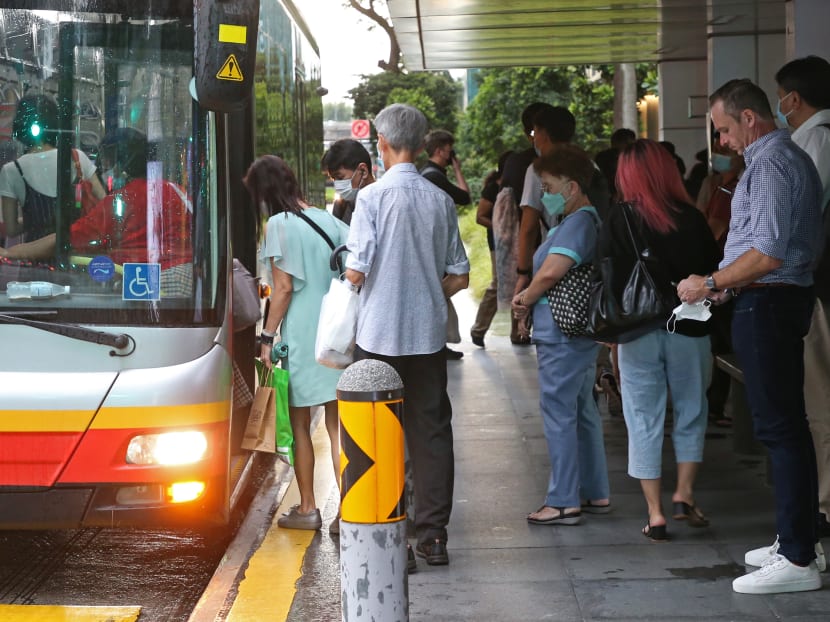Formula used to calculate bus, train fares to be reviewed; changes to be applied in 2023
SINGAPORE — The formula used to calculate bus and train fares will be reviewed for its effectiveness, taking into consideration changes in the public transport industry and commuting patterns, the Public Transport Council (PTC) said on Monday (Aug 15).

- The Public Transport Council is reviewing the public transport fare adjustment formula and mechanism for their effectiveness
- It is doing so as part of a review which is done every five years
- The last time the formula was changed was after the last review in 2018
- Transport analysts said that the latest review will likely take into account the current levels of ridership in public transport, which has fallen below pre-pandemic levels
SINGAPORE — The formula used to calculate bus and train fares will be reviewed for its effectiveness, taking into consideration changes in the public transport industry and commuting patterns, the Public Transport Council (PTC) said on Monday (Aug 15).
This is part of a regular exercise that is done every five years.
In a press release, the council, which regulates public transport fares, said that it aims to complete the review by the first half of next year and apply the outcome of the review in next year’s fare review exercise.
The current fare adjustment formula and mechanism will remain valid for this year’s fare review exercise, added the council.
WHAT DOES THE REVIEW INVOLVE?
Besides reviewing the formula and mechanism, the PTC will also propose how to better maintain the balance to keep fares affordable while ensuring the financial sustainability of the public transport system.
The council said it would consult key stakeholders for the review, such as commuters, public transport operators, the labour movement and transport experts.
HOW ARE FARES CALCULATED NOW?
The current fare formula is pegged to changes in the core consumer price index, the wage index and the energy index (cost changes in electricity and diesel). It also includes a component measuring the productivity of public transport operators and a component called the Network Capacity Factor (NCF).
The NCF was introduced by the PTC after the conclusion of its last review of the fare adjustment formula in 2018. It was included to reflect the recurrent operating costs due to capacity adjustments such as running more trains and buses over longer distances for less crowded and more convenient public transport rides.
This means that if network capacity exceeds ridership, the NCF goes up since it implies a more comfortable ride for the commuter, causing an upward pressure on fare prices.
On the other hand, if ridership far outweighed capacity, implying overcrowding, then the NCF falls or becomes negative.
Last November, the council excluded the NCF from February to December 2020 to coincide with the fall in ridership owing to the pandemic, and only took into account the NCF for the month of January 2020 in its fare review exercise. This was so that fares would not go up drastically.
WHY THE REVIEW MATTERS NOW
While the review is a regular affair, this year’s review comes at a time where public ridership has fallen due to Covid-19.
Analysts had previously told TODAY that the current formula does not account for black swan events like the pandemic.
Associate Professor Michael Li from Nanyang Technological University, a transport researcher, had told TODAY that the pandemic has introduced even more uncertainties and variables to public transport, which will impact how fares are determined in future.
Transport analysts said that the latest review will likely look at whether current ridership levels are now the “new normal” and cover the expenses for the transport system.
Transport analyst Terence Fan from the Singapore Management University pointed out that public transport ridership has yet to return to pre-pandemic levels.
If the council assumes that current ridership levels are “the new normal”, then sticking to the current fare formula would mean having to revise fares upwards. However, the revenue would still not be enough to cover the expenses for the transport system, he said.
“This is the dilemma that the PTC would face at some point. Are they going to assume this is the new normal, or are they going to hope that ridership will rise? It’s not very clear and I guess that is one of the things they want to find out in this review,” he said.
Making a similar point, transport economist Walter Theseira from the Singapore University of Social Sciences said that the PTC will have to consider if the NCF should remain in its present form given that ridership levels have fallen.
He said: “If you apply the NCF, it means you have a structural permanent increase in fares, even if ridership does not go up.”
This was especially so with new MRT lines expected to open over the next five years before the next revision of the fare adjustment formula. The new lines will increase ridership capacity more than the actual increase in ridership.
The NFC increases fares if the growth in services runs higher than ridership. This means that a reduction in fares is unlikely, said Associate Professor Theseira.
The other issue that the council could look into in the latest review is the operating cost structure of public transport and whether there is something more fundamental that needs to be accounted for in the fare adjustment formula besides adjustments for index changes, said Assoc Prof Theseira.
He pointed out that fare revenue is not enough to cover the services of public transport which is currently subsidised by taxpayers' money. For example, train operators receive grants from the Government to cover their maintenance cost.
Assoc Prof Theseira said that one aspect that the review could look at is whether the Government will continue to “fill in the gaps” caused by the inadequacy of the fare adjustment formula with such subsidies, or if the formula should be tweaked to address the shortfall in covering the operating costs of public transport.








